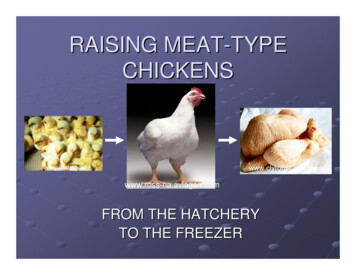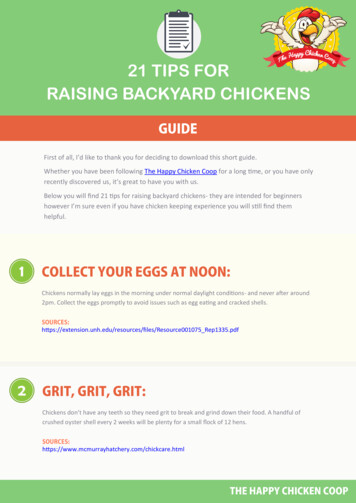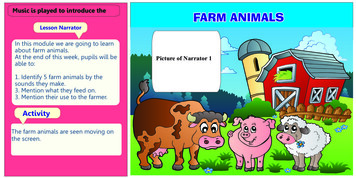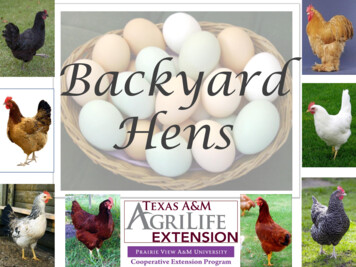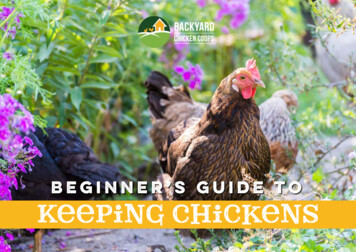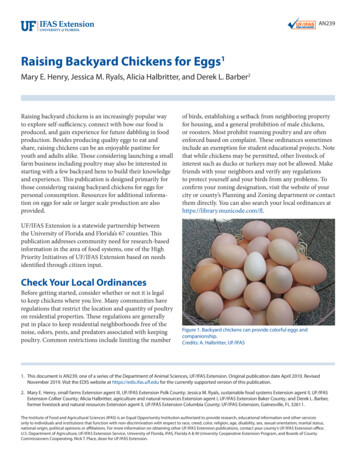
Transcription
AN239Raising Backyard Chickens for Eggs1Mary E. Henry, Jessica M. Ryals, Alicia Halbritter, and Derek L. Barber2Raising backyard chickens is an increasingly popular wayto explore self-sufficiency, connect with how our food isproduced, and gain experience for future dabbling in foodproduction. Besides producing quality eggs to eat andshare, raising chickens can be an enjoyable pastime foryouth and adults alike. Those considering launching a smallfarm business including poultry may also be interested instarting with a few backyard hens to build their knowledgeand experience. This publication is designed primarily forthose considering raising backyard chickens for eggs forpersonal consumption. Resources for additional information on eggs for sale or larger scale production are alsoprovided.of birds, establishing a setback from neighboring propertyfor housing, and a general prohibition of male chickens,or roosters. Most prohibit roaming poultry and are oftenenforced based on complaint. These ordinances sometimesinclude an exemption for student educational projects. Notethat while chickens may be permitted, other livestock ofinterest such as ducks or turkeys may not be allowed. Makefriends with your neighbors and verify any regulationsto protect yourself and your birds from any problems. Toconfirm your zoning designation, visit the website of yourcity or county’s Planning and Zoning department or contactthem directly. You can also search your local ordinances athttps://library.municode.com/fl.UF/IFAS Extension is a statewide partnership betweenthe University of Florida and Florida’s 67 counties. Thispublication addresses community need for research-basedinformation in the area of food systems, one of the HighPriority Initiatives of UF/IFAS Extension based on needsidentified through citizen input.Check Your Local OrdinancesBefore getting started, consider whether or not it is legalto keep chickens where you live. Many communities haveregulations that restrict the location and quantity of poultryon residential properties. These regulations are generallyput in place to keep residential neighborhoods free of thenoise, odors, pests, and predators associated with keepingpoultry. Common restrictions include limiting the numberFigure 1. Backyard chickens can provide colorful eggs andcompanionship.Credits: A. Halbritter, UF/IFAS1. This document is AN239, one of a series of the Department of Animal Sciences, UF/IFAS Extension. Original publication date April 2010. RevisedNovember 2019. Visit the EDIS website at https://edis.ifas.ufl.edu for the currently supported version of this publication.2. Mary E. Henry, small farms Extension agent III, UF/IFAS Extension Polk County; Jessica M. Ryals, sustainable food systems Extension agent II, UF/IFASExtension Collier County; Alicia Halbritter, agriculture and natural resources Extension agent I, UF/IFAS Extension Baker County; and Derek L. Barber,former livestock and natural resources Extension agent II, UF/IFAS Extension Columbia County; UF/IFAS Extension, Gainesville, FL 32611.The Institute of Food and Agricultural Sciences (IFAS) is an Equal Opportunity Institution authorized to provide research, educational information and other servicesonly to individuals and institutions that function with non-discrimination with respect to race, creed, color, religion, age, disability, sex, sexual orientation, marital status,national origin, political opinions or affiliations. For more information on obtaining other UF/IFAS Extension publications, contact your county’s UF/IFAS Extension office.U.S. Department of Agriculture, UF/IFAS Extension Service, University of Florida, IFAS, Florida A & M University Cooperative Extension Program, and Boards of CountyCommissioners Cooperating. Nick T. Place, dean for UF/IFAS Extension.
Is this a 4-H or fair project?4-H is a Youth Development program conducted aroundthe country through land-grant universities like theUniversity of Florida. The program focuses on learning bydoing, and raising chickens is one of the many experientialeducational projects available to participants. Find outmore about 4-H at https://florida4h.ifas.ufl.edu/. Contactyour local UF/IFAS Extension office to learn more aboutthe program. See https://sfyl.ifas.ufl.edu/find-your-localoffice/ for more information.If your interest in raising backyard chickens is related toexhibiting in a fair or as part of a 4-H educational project,verify any specifics required to qualify before gettingstarted. For example, the fair may require animals berecognized breeds rather than mixed or a breed not formally recognized. Visit your local fair for breed inspiration.Find a listing of fairs statewide at https://www.fdacs.gov/and learn more about raising heritage breeds at https://livestockconservancy.org/.HousingWhile social media may feature photos of extravagantchicken palaces, chicken coops do not need to be expensiveor elaborate in Florida. Building your own can be afun project and an opportunity to practice reusing andrecycling materials. Kits and pre-assembled chicken coopsare also readily available at many feed stores and other rurallifestyle suppliers. An area that is covered by a roof andenclosed with a minimum of two sides for protection fromprevailing rain and wind is usually sufficient. The size of thehouse should be based on a minimum of 3 ft2 of floor spaceper bird. Twenty-five birds with 3 ft2 of floor space willrequire 75 ft2 of floor space; a house that is 8 ft x 10 ft willbe sufficient for this example. The use of fencing (chickenwire) helps in confining the birds and provides protectionfrom predators. The top of the enclosure also needs to becovered to prevent flying and climbing predators fromentering. Find several design plans online at https://articles.extension.org/poultry.If your coop will be visible from outside your property,consider its appearance and the impression it may leave onyour neighbors. Your coop can be a bright spot in theneighborhood or a point of contention, largely based on itsappearance and upkeep. Poultry housing structures mayalso fall under your county or city ordinance and haverequirements for required setbacks or permits. Again, referto your local ordinance to verify standards.Raising Backyard Chickens for EggsFigure 2. Attractive coops may be purchased or constructed.Credits: A. Halbritter, UF/IFASFree Range, Mobile Coops, and“Chicken Tractors”Interest in supporting specific production practices hasincreased the number of terms used in the marketplacethat can easily be a point of confusion. According to theUSDA, “free range” means the animal has been allowedaccess to the outside. “Cage-free” indicates the birds haveunlimited access to food and water and can roam theirenclosure; however, they are not required to have accessto the outdoors. For more information, see the USDAwebsite raded-cage-free-eggs-all-theyre-cracked-be).Most backyard chicken enthusiasts want to allow theiranimals access to the outdoors during the day, with securedhousing at night. Using an enclosed run, or additionalprotected yard space, provides an open area that reducesstress and pecking and will allow the birds to supplementtheir diets with greens and insects, which may reduce pestsin your yard. Suggested run size is 8–10 ft2 per bird. Thoseunfamiliar with raising chickens may be unaware that evenjust a few birds in an enclosed yard space can quickly leadto bare ground in the area due to their foraging behaviors.Mobile coops or “chicken tractors” have become morepopular as a way to allow access to forage with the abilityto relocate the coop, reducing the stress on grass and morewidely distributing the droppings of the birds. These coopsmay include a wheel to make moving the structures easier,or they may be designed to pull from one area to the nextby other means. Mobile coops are required in some municipalities and can be a great way to meet the needs of thebirds while protecting the grass. Monitor the condition of2
your grass to determine when to rotate the location of yourmobile coop. Also note that the wider distribution of wastewill increase the distribution of any pathogens it contains,such as Salmonella, which is commonly found in chickendroppings. Keep in mind that in the event of a hurricane ormajor weather event, mobile coops will need to be stored inan enclosed area to avoid becoming a hazard.NestingAs the birds reach the age of 18–20 weeks, nesting boxesshould be in place. Boxes that measure 12 x 12 x 12 inchesand are half filled with straw or wood shavings are ideal.Provide at least one nest box for every five hens in the flock,and place them about two feet above the ground. A perchmay be placed in front of each box, allowing a spot for hensto land before entering the box. A wide range of materialsmay be creatively reused for nesting boxes, includingrepurposed buckets or milk crates.Choosing a FeedFigure 3. Mobile coops can help reduce damage to grass.Credits: J. Ryals, UF/IFASPredatorsPredators will be a risk factor for your birds. A mobile coopmay increase vulnerability to predators, because they maymore easily burrow under a mobile rather than stationary coop. You may experience a wide range of potentialpredators from dogs and cats to wildlife, such as hawks,owls, foxes, coyotes, raccoons, and opossums. Hardwarecloth is screening similar to chicken wire, but it uses atighter wire spacing pattern, reducing the opening size andbetter protecting your birds from smaller predators such assnakes, pests, or rats, which may be attracted to your bird’sfeed and eggs. It is recommended that stationary coopsinclude chicken wire or other barriers buried 12–18 inchesin an L-shape at the perimeter of the structure to deterpredators from digging their way inside.Figure 4. Bury fencing to prevent burrowing predators.Credits: A. Halbritter, UF/IFASRaising Backyard Chickens for EggsGood nutrition is very important in maintaining a healthyflock. Backyard enthusiasts may envision allowing yardaccess to meet a significant portion of nutritional needs;however, research has shown that only a small portion ofthe bird’s basic nutritional needs may be met by foraging.Forage, scraps, or other supplements may displace feedintake, which can actually reduce or dilute the essentialnutrition for healthy maintenance and growth. Providingfree access to feed will ensure optimum growth and development. An estimated 70% of the cost of raising chickenscan be attributed to feed; however, this is an investmentrather than an expense. The better the birds are fed, themore productive they will be. Inadequate or dirty water,stale or rancid feed, mold, disease, and heat can inhibit feedand water intake. Additions of scraps and other supplements are addressed later in the publication.Commercially available feed comes in three different forms:mash, crumble, and pellets. The shape of the feed does notaffect the nutrition it provides, and determining which oneto use is largely a matter of personal preference. Note thatchickens do not have teeth and large pellets are not suitablefor chicks due to the size. Pellets may reduce waste due tospills for larger birds. Experiment to see what works best foryou.Using the right feed for the growth stage and purpose ofyour birds is important. Starter and grower feeds contain ahigher percentage of protein to meet the growth needs ofyoung birds, and layer feeds contain the higher percentagesof calcium necessary for egg production. If fed layer feed,chicks will develop kidney problems and rickets sincechicks will not use the extra calcium, and the calciumto phosphorus ratio will be put out of balance. Expectreduced growth, unnecessary stress, and potentially highermortality rates if layer feed is fed to chicks. Roosters shouldnot consume layer feed, either, since they will not be usingthe extra calcium; only laying-age female poultry should3
consume layer feed. If you have a mixed species flock(e.g., guinea hens, turkeys, waterfowl, etc.), all-flock feedis available and formulated to provide for specific nutrientrequirements for various species.Figure 5. Commercial feeds are formulated to provide nutrition basedon stage of growth.Credits: J. Ryals, UF/IFASDiet Transitions for Females Intended asLayers0–6 Weeks: The starter diet for chicks has the highest level of proteina chicken will receive during its lifetime to support rapidgrowth. Newly hatched chicks will require a commercialstarter feed (20–24% protein) that is usually fed until sixweeks of age. Expect to use at least four pounds of starterfeed per bird.6–18 Weeks: After six weeks, switch to a grower feed (16–20%protein), and feed this up to 18 weeks of age. Many feedstores carry a combination starter/grower feed that willwork well for both stages of growth. If the chicks aremale, then they can be fed the same starter or starter/grower feed as the females until six weeks of age and thenswitched to the grower feed indefinitely. Do not feed layerfeed to males. If your flock includes males, an all-flockblended feed may be a good choice to reduce confusionand risks of imbalanced nutrition for parts of your flock.18 Weeks and Older: At 18 weeks, switch to a layer feed (14–16% protein) toprepare the birds for egg production. Layer feed normallycontains approximately 3.5–4.0% calcium; however, birdsless than 18 weeks old require only about 1% calciumin their diet. Do not feed layer feed to birds less than 18weeks old or starter/grower feed to birds producing eggs,because there is inadequate calcium in starter/growerfeeds to support egg production.Raising Backyard Chickens for Eggs Calcium (e.g., crushed oyster shell, ground or largeparticle limestone) and hard, insoluble granite, alsocalled grit, may be mixed in a commercial feed or can beprovided as a free-choice supplement. Note that calcium and grit are not the same. Grit isinsoluble and stored in the gizzard of the bird whereit is used to physically grind food during digestion,while calcium is soluble, absorbed, and metabolizedfor eggshell formation. Commercial feeds are designedto be highly digestible, which may reduce or eliminatethe need for grit; however, birds with access to awider-ranging diet (such as in backyard foraging) maytake in less digestible food that may require grindingfor adequate digestion. Your birds may also pick upsmall stones in your yard that may reduce the need forsupplemental grit. During hot weather, chickens willgenerally consume less feed, and free-choice access tocalcium will provide the calcium needed for qualityeggs.Medicated FeedCoccidiosis is a disease caused by a microscopic parasite(protozoan) that infects the intestinal tract. Young birds areparticularly susceptible to the disease. Commercial starterfeeds may include medication to control coccidiosis and ifso, they will be clearly labeled as medicated. Before choosing medicated feed, be sure to ask if the birds have alreadybeen vaccinated for coccidiosis. Medicated feeds counteractthe live vaccine; therefore, do not use medicated feed forbirds already vaccinated for coccidiosis. Booster vaccinations are not required. Grower and layer feed usually do notcontain medication.Non-medicated starter feed is available to use for thosebirds receiving a coccidiosis vaccination or for the poultryowner choosing a more organic production system. Chicksare particularly susceptible to coccidiosis because they havenot yet built an immunity to infection. Over time, however,chickens will naturally develop immunity after exposure.Vaccination or medicated feed provides early protectionduring the most vulnerable stage of the bird.Choosing not to vaccinate or use medicated feed willincrease your flock’s risk of illness and mortality. Note thatthe protozoan parasite that causes coccidiosis and its eggsare commonly found in the droppings of chickens andother birds. One reason wire floors are used in commercialpoultry production is to improve sanitation and reducethe birds’ exposure to their waste and any pathogens itmay contain. While backyard chicken enthusiasts may not4
envision using wire floors, and prefer to avoid vaccinationsor medicated feed, it is important to understand that thesechoices may leave your flock at increased risk of illness orhigher mortality due to coccidiosis. For more information,see EDIS document PS47, Common Poultry Diseases(https://edis.ifas.ufl.edu/ps044) and EDIS document VM76,Intestinal Parasites in Backyard Chicken Flocks (https://edis.ifas.ufl.edu/vm015).Table Scraps and Other SupplementsUse caution when offering scraps and other non-stapleadditions to your bird’s diet. Note that these can affect thenutritional balance of their diet and may even increasestress due to limited digestibility of some foods. Note thatdigestion requires energy and generates heat. Foods thatare not readily digestible for your birds may increase therisk of overheating, especially in high temperatures. Addingscratch or cracked corn to a well-balanced diet can beentertaining, but it does not provide the adequate proteinand other nutrients needed by your birds and might bethought of as a treat rather than a staple of the diet. Birdsconsuming more grains will eat less of the complete nutrition provided by feed, reducing the overall nutritional valueof the diet.Poultry supplements are a point of discussion in onlineforums and magazines, but there is often a lack of scientificevidence to back up the claimed benefits of the suggestedsupplement. The role of UF/IFAS Extension is to shareresearch-based information to help the public make decisions. Without validated research to anchor supplementrecommendations, chicken enthusiasts should approachsuggestions with skepticism to avoid adding expenseswithout seeing results.The addition of vinegar to poultry water is often a pointof interest. This practice is used in commercial meat-birdproduction to promote gram-positive bacteria and reduceSalmonella in the bird’s crop. In some studies, vinegar hasbeen shown to be effective in controlling certain bacteria;however, there is no scientific evidence to support thisclaim in live poultry (Griggs and Jacob 2005). Electrolytesupplements may also be a point of interest. These are additions to the water targeted to help with loss of electrolytesunder high temperature conditions that can lead to dehydration. These supplements may help to reduce the effectsof heat stress but are not necessary for the health of the birdas long as fresh, clean water is always available. Whenevera supplement is used, manufacturer instructions for dosingand length of administering should be followed.Raising Backyard Chickens for EggsPeriodic interest has also been shown in growing variouscrops as a feed source or supplemental feed source forbackyard chickens. There is not a lot of information on thispractice for Florida, but national sustainable agricultureresources such as ATTRA may be helpful. See more aboutATTRA at https://attra.ncat.org/.Organic ProductionInterest in organic production is on the rise. USDA organiccertification is available, but it is not very practical forbackyard production because of the certification costsinvolved. Organic livestock production requires 100%certified organic feed, which is readily available at manyfeed stores but may be more expensive than conventionalfeed. Do not allow your chickens to forage in areas treatedwith herbicides or other pesticides not approved for organicproduction. Explore the USDA certified organic livestockstandards at https://www.usda.gov/topics/organic.If not planning to use organic practices, it is still importantto note that any pesticides or fertilizer applied to your yardcould be ingested by your birds. If pesticides or fertilizersare applied in your yard, be sure to follow any label instructions regarding safe reentry to a treated area. If you suspectyour hens may have ingested pesticides or been exposed toareas treated with pesticides, discard the eggs for severaldays to prevent consumption.What Not to Feed Your BirdsWatching your flock feed on kitchen scraps can be anenjoyable way to add nutrition to their diet, but too manytable scraps can adversely affect growth and egg production.Avoid fatty, salty, sugary, or rotten foods. Never feed thefollowing to your flock: Raw green potato peels Nightshades such as rhubarb, pepper, potato, eggplant, ortomato leaves Raw, dried, or undercooked beans Avocado skin and pit Candy, chocolate, sugar Alcohol and tobacco(Pitesky and Reimers n.d.)Poisonous Plants, Weeds, andOther ConcernsSeveral commonly used landscape plants and various weedscontain toxins that may be poisonous. Toxins often make5
plants smell or taste bad, and their seeds, in particular, canbe toxic. Young animals, especially, may eat these plants outof curiosity. Common symptoms of toxic plant poisoningmay include weight loss, diarrhea, lethargy, decreased eggproduction, and increased mortality. Determining whetheryour birds have eaten poisonous plants can be difficultbecause the effects can vary with the amount they haveeaten and other factors like temperature. If you removetoxic plants from your yard, don’t leave them piled up foryour flock to access. Providing enough good food sources,suitable fencing, and space can reduce the risk of yourchickens ingesting toxic weeds.Lists of toxic or poisonous plants are not exhaustive andare not assembled specifically for poultry. Therefore, theycan be useful but are unlikely to be complete or conclusive.See Tables 1 and 2 for guidance on poisonous plants andfamiliarize yourself with poisonous plants at https://www.poison.org/articles/plant. Information on poisonous plantsis available at .Table 1. Examples of potentially hazardous weeds.Scientific NameCommon Name(s)Crotalaria sp.RattleboxCassia obtusifoliaSicklepod; coffeepod; coffeeweedCassia occidentalisCoffee sennaSesbania macrocarpaDanglepod; hemp sesbaniaDatura stramoniumJimsonweed; angel’s trumpet; devil’s weed;thorn apple; tolguacha; Jamestown weed;stinkweed; datura; moonflowerArgemone mexicanaMexican prickly poppyAbrus precatoriusRosary pea(Damron and Jacob 2001)Table 2. Examples of potentially hazardous landscape plants.Scientific NameCommon Name(s)Rhododendron spp.AzaleasNerium oleanderOleanderLantana camaraLantanaColocasiaElephant earIlex spp.HollyCaladiumCaladium(Poison Control 2019)WaterA constant supply of clean, fresh water is essential forhealthy birds. Manufactured chick waterers usually consistof a quart or gallon jar with a screw-on base that allows forwater level adjustment. An automatic waterer placed sixinches above the ground is the most adequate way to ensureRaising Backyard Chickens for Eggsthe birds have clean, fresh water daily. Twenty-five henscan drink a gallon of water each day. Expect and encouragea significant increase in water consumption during hotweather. Note that standing water or unlevel, leakingwaterers can harbor pests and allow bacterial growth thatleads to odors and possibly disease. Maintain clean and drycoop conditions to support the optimal health of your birds.Egg ProductionEgg production for a small backyard flock should be about200–240 eggs, or 17–20 dozen, per hen a year. Productionwill vary based on breed, age, condition of the bird, and daylength. Shorter day length may decrease the number of eggsproduced because light stimulates egg production. Addinglight at the beginning or end of the day to provide 14–16hours of light per day is effective to maintain egg production throughout the year. A simple clamping light sourceon a timer can be added inside the coop to increase lightexposure, but lights must be turned off for a period of thenight to reduce the risk of stress-associated cannibalism.Note that chickens will also experience a periodic molt inwhich they lose their feathers and generally decrease laying.This is a natural part of the bird’s life cycle and does notindicate a problem. The molt will last for a period of weeks,and your bird will usually return to regular egg productiononce the molting process is over. Consider that with ageyour hens will reduce the number of eggs laid; in whichcase, feed costs may exceed the financial benefit of the eggsproduced. Some backyard chicken owners may chooseto continue to keep their birds for companionship, whileothers may look to euthanize and replace those hens withyounger, more productive birds.For more information, see EDIS document PS-35, FactorsAffecting Egg Production in Backyard Chicken Flocks(https://edis.ifas.ufl.edu/ps029).How many roosters do I need?If you have ever wondered how many roosters are requiredfor hens to produce eggs, you are not alone. The generalpublic’s distance from food production experience hasmany suspecting that roosters may be required in order toinduce hens to lay eggs, but this is not the case. Roostersare male chickens and are not required in order for femalechickens, hens, to lay eggs. When mature, the hen will layeggs as a regular reproductive function of the body. Roosters are required, however, for fertilized eggs that will laterhatch into chicks.6
runny waste droppings on them, this may be an indicationof a problem with your birds. Do not use excessively dirtyor cracked eggs, since bacterial contamination is possible.Figure 6. Roosters are not required for hens to lay eggs.Credits: A. Halbritter, UF/IFASCollecting and Cleaning EggsNesting boxes should be checked at least once a day foreggs. Eggs should not be allowed to accumulate in the nests.Otherwise, the hens will go out of egg production andwant to sit on the eggs to incubate them. This type of henis commonly referred to as a “broody” hen. Keep nestingboxes clean to help prevent dirty eggs. The more time theegg spends in the nest, the more likely it is to become dirty,broken, or low quality. Ceramic or wooden eggs can beused to help encourage your hens to use the nesting boxes.Although eggshells appear solid, they actually contain poresto allow for gas exchange and are covered by a protectivemucus, deposited as it is laid, known as the cuticle or“bloom.” Differences in opinions on cleaning are related todifferent production standards, practices, and interpretations of risk priorities. Although eggs may not be washedor refrigerated in other parts of the world, farmers in thoseareas may also be required to immunize for Salmonellaand authorities may consider the risk of condensationduring refrigeration worse than the benefits of washingand refrigeration. They may also be required to not usedirty eggs rather than cleaning them. Note that washingand sanitizing eggs are required if you intend to sell eggsunder the Limited Poultry Permit, referenced later in thispublication.Figure 8. Eggshells contain pores which may allow microbes inside.Credits: A. Halbritter, UF/IFASFigure 7. Keep nesting boxes tidy to reduce food safety risks.Credits: A. Halbritter, UF/IFASCleaning and storing eggs is a point of discussion amongbackyard chicken enthusiasts, and requirements for safe egghandling are inconsistent across states and countries, especially for small numbers of eggs. Understanding the riskof foodborne illness, particularly Salmonella, is importantwhen deciding how to clean your eggs. Use eggs when theyare fresh or store them properly. If your eggs are dirty withRaising Backyard Chickens for EggsFor dry cleaning, a brush or light sanding may be used toremove any dirt or debris. When washing eggs, use waterat temperatures of at least 90 F and at least 20 F warmerthan the eggs. Cooler water can create a vacuum, pullingwash water and any microbes it may contain through theshell pores to the inside of the egg. Under high heat conditions, you may need to let eggs cool to room temperaturebefore washing. Avoid immersing the eggs in water anduse disposable paper towels to clean each one. Unscented,nonfoaming dish soap may be used for cleaning. Whenusing sanitizers, be sure to follow the directions and notethat sanitizers will not be effective if used in dirty water oron dirty eggs. A solution of 1 or 2 tablespoons of bleachto 1 gallon of water can be used as a sanitizer. Once theeggs have been washed, rinsed, and sanitized, they shouldbe dried before being stored in refrigeration at or below7
45 F. Eggs should be stored with the larger side up for bestquality. If stored properly, refrigerated eggs should have ashelf life of 6 to 8 weeks. Date the storage carton and useolder eggs first.Choosing a BreedWorldwide, there are over 400 formally recognized breedsof poultry, each with characteristic personalities, sizes, andintended purposes. Chicken breeds generally fall into oneof three categories: laying types, meat-bird types, and dualpurpose, which are kept for both meat and eggs. Breeds thatmay work well for dual purpose include the Rhode IslandRed, Plymouth Rock, New Hampshire, Wyandotte, andOrpington. Dual-purpose birds will consume more foodand be larger than laying birds, and therefore may requiremore space or increase cost of production compared tosmaller laying breeds such as the White Leghorn.Egg-laying breeds will have varied personalities, feathercolor, size, and egg traits. Some chickens lay white eggs,some lay brown, and some lay blue or green eggs. Eggshellcolor is based on the breed of the bird and does not affectthe nutritional value of the egg. The nutritional value ofthe egg is a direct product of the nutrition of the bird. Still,brown or colorful eggs may be considered more attractivebecause they are less common than white. Breed will alsodetermine the number of eggs per year a chicken will lay.Some breeds, like the Golden Comet, produce as many as300 eggs per year, while others may lay as few as 150 eggsannually. The most common bird used for commercial eggproduction is the White Leghorn. While the leghorn strainof chicken will produce the most eggs, these birds are quitesmall and
Raising Backyard Chickens for Eggs 2 Is this a 4-H or fair project? 4-H is a Youth Development program conducted around the country through land-grant universities like the University of Florida. The program focuses on learning by doing, and raising chickens is one of the many experiential
